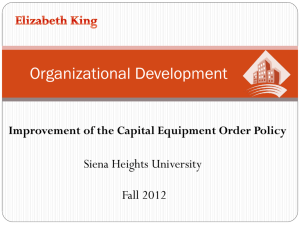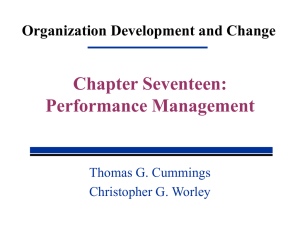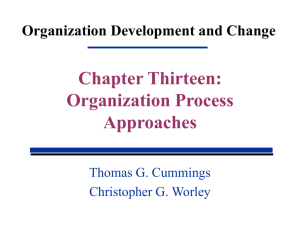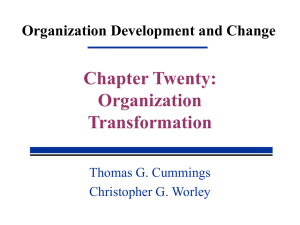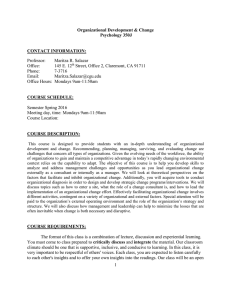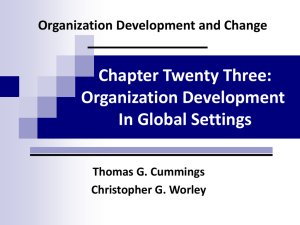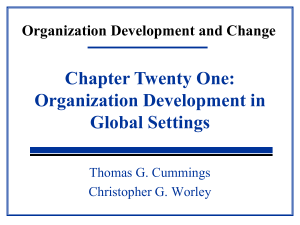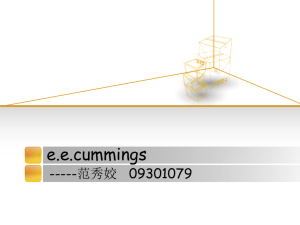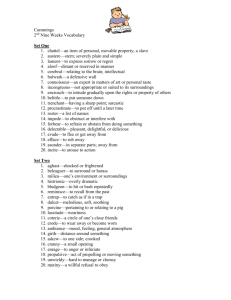Performance Management
advertisement
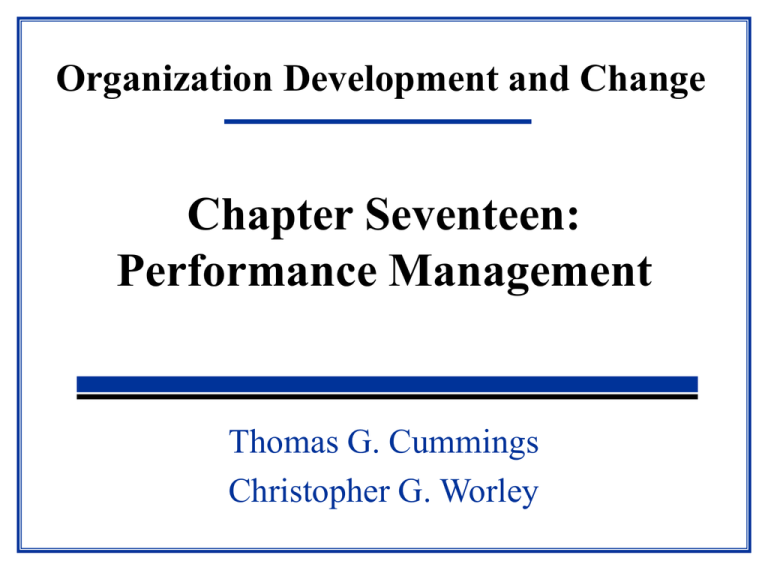
Organization Development and Change Chapter Seventeen: Performance Management Thomas G. Cummings Christopher G. Worley Learning Objectives for Chapter Seventeen • To present a model for understanding the components and relationships associated with performance management • To explore three interventions concerned with managing the performance of human resources: goal setting, performance appraisal, and reward systems Cummings & Worley, 7e (c) 2001 South-Western College Publishing 17-2 A Performance Management Model Business Strategy Goal Setting Individual and Group Performance Performance Appraisal Cummings & Worley, 7e (c) 2001 South-Western College Publishing Employee Involvement Reward Systems 17-3 Characteristics of Effective Goals • Goals are Challenging – Challenging but realistic – Goals are set participatively • Goals are Clear – Goals are specific and operationally defined – Resources for goal achievement are negotiated Cummings & Worley, 7e (c) 2001 South-Western College Publishing 17-4 MBO Application Stages • Involve the whole work group • Goals set jointly by manager and subordinate • Action plans are established • Criteria and yardsticks are established • Work progress and contract reviewed and adjusted periodically • Records of meetings are maintained Cummings & Worley, 7e (c) 2001 South-Western College Publishing 17-5 Performance Appraisal Elements Elements Traditional View Newer View Purpose Organizational, legal Fragmented Developmental Integrative Appraiser Supervisor or manager Appraisee, co- workers, and others Active participant Role of Passive recipient Appraisee Measurement Subjective Objective and Concerned with validity subjective Timing Period, fixed, administratively driven Cummings & Worley, 7e (c) 2001 South-Western College Publishing Dynamic, timely, employee- or workdriven 17-6 Performance Appraisal Application Stages • Select the appropriate stakeholders • Diagnose the current situation • Establish the system’s purposes and objectives • Design the performance appraisal system • Experiment with implementation • Evaluate and monitor the system Cummings & Worley, 7e (c) 2001 South-Western College Publishing 17-7 Characteristics of Effective Appraisal Systems • • • • • • Timely Accurate Accepted by the users Understood Focused on critical control points Economically feasible Cummings & Worley, 7e (c) 2001 South-Western College Publishing 17-8 Characteristics of Effective Reward Systems • • • • • • Availability Timeliness Performance Contingency Durability Equity Visibility Cummings & Worley, 7e (c) 2001 South-Western College Publishing 17-9 Types of Rewards • Pay – – – – – Skill-based pay plans All-salaried work force Lump-sum salary increases Performance-based pay systems Gain sharing • Promotions • Benefits Cummings & Worley, 7e (c) 2001 South-Western College Publishing 17-10 Salary-Based Pay for Performance Ratings Individual Plan Productivity Cost effectiveness Superiors’ rating 4 3 3 1 1 1 1 1 1 4 4 3 Group Productivity Cost effectiveness Superiors’ rating 3 3 2 1 1 1 2 2 2 4 4 3 Organization- Productivity wide Cost effectiveness 2 2 1 1 3 2 4 4 Cummings & Worley, 7e (c) 2001 South-Western College Publishing 17-11 Stock/Bonus Pay for Performance Ratings Individual Plan Productivity Cost effectiveness Superiors’ rating 5 4 4 3 2 2 1 1 1 2 2 2 Group Productivity Cost effectiveness Superiors’ rating 4 3 3 1 1 1 3 3 3 3 3 3 Organization- Productivity wide Cost effectiveness Profit 3 3 2 1 1 1 3 3 3 4 4 3 Cummings & Worley, 7e (c) 2001 South-Western College Publishing 17-12 Gain Sharing Pay Plan Considerations • Process of design - participatively or topdown? • Organizational unit covered - plant or companywide? • Determining the bonus - what formula? • Sharing gains - how and when to distribute? • Managing change - how to implement system? Cummings & Worley, 7e (c) 2001 South-Western College Publishing 17-13
